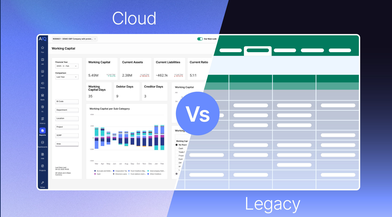
Today’s CFO isn't just a number-cruncher or someone holding the purse strings when budget season comes around.
The role has significantly evolved, where they now play a key part in data strategy, technology adoption and business transformation.
“Other functions play into the finance function. The CFO has to embed processes across operations, not just in finance,” says James Hunter, CFO at AccountsIQ. “The need for smart, data-rich insights that can easily be shared across the business has become more important than ever. ”
It’s worth noting that almost a third (29%) of finance leaders have concerns about the accuracy of their financial reporting, which points to an appetite for significant improvements in this area.
With that in mind, here are nine key reports to look at if you want to transform your finance function into a fiery engine room for more intelligent decisions, leaner operations, and long-term resilience in a volatile, competitive landscape. Let’s get into it.
9 reports leading CFOs look at every month
1. Cash flow forecast
If, as they say, ‘cash is king’, then clarity is queen. A robust cash flow forecast doesn’t just let you know whether or not you can pay your bills month to month; it gives you the gift of foresight.
You're mapping out potential gaps, spotting opportunities to reinvest and planning for best- and worst-case scenarios. Stronger forecasting can be a mission-critical tool for SMEs looking to avoid cash flow crises and keep investor confidence up.
Top CFOs refer to this report not just monthly, but week-to-week, particularly when there’s a shift in growth plans or market conditions change significantly.
2. Balance sheet analysis
A balance sheet might look a little basic at first, but analyse it properly, and it’s a goldmine of insights.
It showcases everything from how well your assets are performing to how efficiently you're using capital, and how vulnerable you are to risk. Looking into debt-to-equity ratios, liquidity, and retained earnings gives CFOs the edge in board discussions and funding conversations. According to the Financial Reporting Council, transparency in balance sheet reporting is essential for maintaining investor trust and financial accuracy.
If you want your finance team to act more like analysts than administrators, this is the report that sets the tone.
3. Income statement and profitability metrics
The income statement is the report everyone at the table wants to see. But it’s not just about revenue and costs; it’s about margins, momentum, and uncovering which levers you can pull.
Gross margin slipping? Time to look at procurement. Operating margin flatlining? Dig into team structures or automation opportunities. And while the standard metrics matter, the best of the best go a bit further: layering in trends, ratios, and comparisons to industry benchmarks.
4. Cash flow statement
This isn’t your forecast. It’s the real deal, the source of truth. A cash flow statement shows how money moves around your business in practice, organised into operations, investment, and financing.
If you’re profitable on paper but frequently tight on cash, this is where you’ll find the disconnect. It helps you understand burn rate, identify seasonal cash flow patterns, and figure out whether or not operational efficiency is translating into liquidity.
Finance leaders who track this consistently are in a far better position to negotiate lines of credit, manage dividend policies, and confidently forecast capital investment.
5. Budget and revenue variance analysis
Let’s be brutally honest: no budget survives a brush with the real world. That’s why variance reports need to be in your back pocket.
When you can easily explain why and how things didn’t go to plan—and whether that’s a good thing or a bad one—you shift from reactive to proactive finance. It’s not about pointing fingers; it’s about understanding what’s working, what’s not, and how you need to pivot as a business.
So in short: if you want to make your board-level updates sharper, present this alongside strategic commentary and forward-looking actions to hit a home run.
6. Capital structure and debt analysis
Debt isn't the enemy—unmanaged debt is the real villain.
This report helps you get a clear picture of not just how much you owe, but the nature of the debt, how much it costs, and when it needs to be paid. It gives you a sense of risk, flexibility, and appetite for growth.
Whether you're gearing up for M&A, navigating interest rate shifts, or just trying to optimise your cost of capital, having visibility on your capital structure is critical. The Bank of England’s corporate borrowing trends are worth tracking when shaping your own strategy.
7. Accounts receivable and payable
You might be in profit, but if receivables are delayed or your payables are mismanaged, your cash reserves will drain fast.
Tracking aged receivables and days sales outstanding (DSO) shows how efficient your collections process really is. On the other side, days payable outstanding (DPO) helps you strike the right balance between supplier relationships and working capital.
This report is where operations and finance collide, so collaboration is a must.
8. Performance and KPI reporting
KPI dashboards are often either overengineered or underutilised. The key to finding that sweet spot? Choosing metrics that are relevant, consistent, and linked to wider strategic goals. Whether it’s EBITDA, customer acquisition cost, or project profitability, the right KPIs act as your early-warning system.
Just remember: metrics are only as useful as the conversations they support. Leverage them to challenge long-held assumptions and push for better, rather than just reporting on what’s already happened.
9. Internal productivity and customer insights
This one’s often missed off the list by traditional finance teams—but not by eagle-eyed CFOs armed with the right accounting software.
Reporting on internal productivity (E.g. revenue per employee, finance cost per transaction) and customer trends (E.g. churn rate, lifetime value) aligns finance to commercial strategy more closely.
It’s also the foundation for identifying process improvements, automation opportunities, and smarter resourcing decisions.
What’s next for your reports?
These nine reports aren’t about ticking boxes or impressing stakeholders. They’re all about owning the numbers that empower your team to make smarter decisions, drive growth, and pave the way to a more resilient business. In short: they’re how high-performing CFOs lead, rather than follow.
And with the right tools in place, turning financial data into strategic insight doesn’t need to be hard. Better reporting, better visibility, better outcomes. Because better begins now, with you.
Kelly Dent is a writer and editor with over 10 years’ experience across a range of industries, from accounting and AI to cloud technology, entrepreneurship, and beyond.
Want to learn more about the impact of advanced reporting? Download AccountsIQ's free eGuide today.


